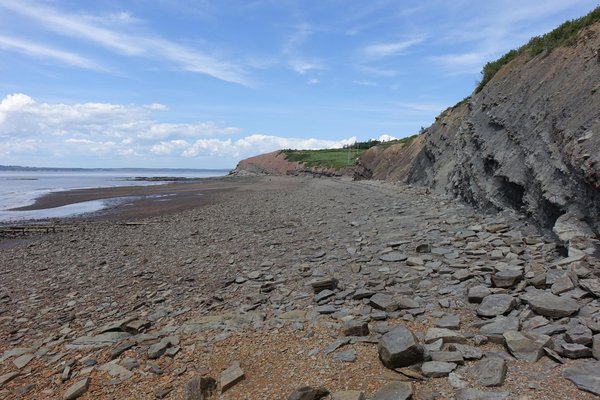Canada
Joggins Fossil Cliffs
The Joggins Fossil Cliffs hold the most complete fossil record from the "Coal Age" of Earth's history, approximately 310 million years ago.
At the 14.7km stretch of cliffs, the fossilized remains of a coastal forest are exposed, including upright trees and terrestrial fauna such as the earliest known reptile. The fossils have remained in situ, in their complete ecosystem. Joggins also figures in Darwin's "On the Origin of Species".
Community Perspective: its attractive location at the Bay of Fundy (with the world’s highest tidal range) is a bonus. You can visit the fossil beach on your own or with a guide; most fossils on display there are of plants and trees.
Site Info
Official Information
- Full Name
- Joggins Fossil Cliffs (ID: 1285)
- Country
- Canada
- Status
-
Inscribed 2008
Site history
History of Joggins Fossil Cliffs
- 2008: Inscribed
- Inscribed
- Type
- Natural
- Criteria
- viii
Links
- UNESCO
- whc.unesco.org
- Official
-
- jogginsfossilcliffs.net — Joggins Fossil Cliffs
- Related
-
- uwaterloo.ca — Information by the University of Waterloo
All Links
UNESCO.org
- whc.unesco.org — whc.unesco.org/
Official Website
- jogginsfossilcliffs.net — Joggins Fossil Cliffs
Related Resources
- uwaterloo.ca — Information by the University of Waterloo
News Article
- Sept. 12, 2012 upi.com — Tiniest fossil dinosaur footprints found
- March 1, 2010 amherstdaily.com — Joggins Fossil Cliffs continuing to show strong tourism numbers
- July 20, 2008 ctv.ca — New visitors to Joggins Cliffs taking souvenirs like rocks or even fossils
- July 12, 2008 canada.com — Nova Scotia's Joggins Fossil Cliffs have been inscribed on the World Heritage List
Community Information
- Community Category
- Paleontology: Non-hominid fossils
Travel Information
Recent Connections
-
Petrified wood
Holds many types of fossilized trees, i…
-
Linear inscriptions
A narrow strip along the coastline
-
Paleozoic
dating to the Pennsylvanian "Coal Age" …
Connections of Joggins Fossil Cliffs
- Individual People
-
-
Charles Darwin
The fossil record at Joggins figures in Darwin's On the Origin of Species
-
- Geography
-
-
Atlantic Ocean
The cliffs are at the Bay of Fundy, which flows into the Gulf of Maine (a large gulf of the Atlantic Ocean).See en.wikipedia.org
-
Linear inscriptions
A narrow strip along the coastline
-
Estuary
"the site groups remains of three ecosystems: estuarine bay, floodplain rainforest and fire prone forested alluvial plain with freshwater pools." (Official description)
-
- Trivia
-
-
Dubbed as another WHS
"Coal age Galapagos" because of the assistance they gave to Darwin, Lyall et al in developing their understanding of earth and life science.
-
- Ecology
-
-
Lagerstätten
(Carboniferous) "A fossil site that preserves a diverse terrestrial ecosystem consisting of plants like lycopsids, giant arthropods, fish, and the oldest known sauropsid, Hylonomus." (Wiki)See en.wikipedia.org
-
Petrified wood
Holds many types of fossilized trees, including tree trunks (source)
-
Tidal effects
Fundy Bay with the highest tides in the world. The beach cannot be visited during high tides. -
Notable Trees
The seams preserve, mostly as casts, the upright fossilized trunks of trees up to 7.6m high, which grew in a poorly drained disturbance-prone deltaic plain. There they were preserved by burial 3-4 m deep in flood-deposited alluvial sands and mud (UNEP-WCMC) -
Fossils
The “grand exposure” of rocks at Joggins Fossil Cliffs contains the best and most complete known fossil record of terrestrial life in the iconic “Coal Age”: the Pennsylvanian (or Carboniferous) period in Earth’s history. (Crit viii)
-
- World Heritage Process
-
-
WHC locations
Quebec (2008) -
Perfect Inscriptions
2008 -
Inscribed on a single criterion only
viii. to be outstanding examples representing major stages of earth's history, including the record of life, significant on-going geological processes in the development of landforms, or significant geomorphic or physiographic features
-
- Human Activity
-
-
Coal Mining
"Coal was mined in the 17th and 18th centuries by the first French colonists and continued in the Joggins Formation (beside and underlying Joggins village) intermittently from 1847 on, some galleries running underwater into the bay. The gritstone of Boss Point was used for a successful grindstone business in the 19th century. The village of Joggins immediately above the cliffs has always been dependent on coal mining, which ended there only in 1961, leading to local economic decline. " (AB ev)
-
- WHS on Other Lists
-
-
IUGS Geological Heritage Sites
“Coal Age” Joggins Fossil Cliffs
-
- Timeline
-
-
Paleozoic
dating to the Pennsylvanian "Coal Age" during the Late Carboniferous Period - the Carboniferous is a geologic period and system of the Paleozoic that spans 60 million years from the end of the Devonian Period 358.9 million years ago (Mya), to the beginning of the Permian Period, 298.9 million years ago (wiki)
-
News
- upi.com 09/12/2012
- Tiniest fossil dinosaur footprints…
- amherstdaily.com 03/01/2010
- Joggins Fossil Cliffs continuing t…
- ctv.ca 07/20/2008
- New visitors to Joggins Cliffs tak…
Recent Visitors
Visitors of Joggins Fossil Cliffs
- Adam Hancock
- Alexander Barabanov
- Alex Goh
- Ammon Watkins
- Ana Lozano
- Anne
- Antonio J.
- Argo
- Atila Ege
- AYB
- Bram de Bruin
- brornt
- Can SARICA
- Carlo Sarion
- Cluckily
- CynthiaW
- dave wood
- David Aaronson
- David Scott King
- Els Slots
- Frédéric M
- FS
- Gary Arndt
- George Gdanski
- GeorgeIng61
- Gernot
- Harald T.
- Harry Mitsidis
- Iain Jackson
- Jacob Choi
- Janos
- Jarek Pokrzywnicki
- Jason Boulette
- Jawnbeary
- Jay T
- Jeanne OGrady
- Jonas Hagung
- Jonas Kremer
- Lara Adler
- Lembu
- Lillybett
- Lithobates
- Loic Pedras
- Ludvan
- Luis Filipe Gaspar
- Matthewsharris
- Mazeman
- MH
- Michael Ayers
- michaelsballard
- Mihai Dascalu
- Mikko
- Morodhi
- Mstrebl1990
- Naim Y
- natlefebvre@hotmail.
- Nihal Ege
- Philipp Leu
- Philipp Peterer
- Randi Thomsen
- Reisedachs
- Roger Ourset
- Roman Bruehwiler
- Simonh
- Slavi
- Svein Elias
- Szucs Tamas
- Thomas Buechler
- Thomas van der Walt
- Tim Allen
- Tranvianoruega
- Van Hung
- Wojciech Fedoruk
- ZCTLife
- Zoë Sheng
Community Reviews
Show full reviews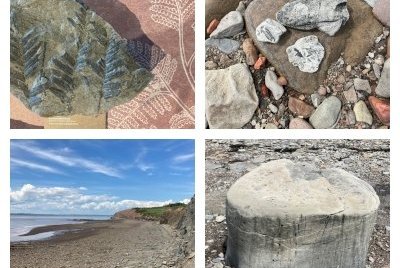
I visited Joggins on a Sunday afternoon. I had made reservations for the 2 pm tour weeks in advance. After about 6 hours of driving from the province of Québec (plus an hour time difference), I arrived on time. The visitor center is a lot smaller than Miguasha's, and it seems to be less well funded too: Joggins is owned by a foundation, it is not a provincial or national park.
It turned out that only 2 other people (Americans) were joining me on the tour. I first had a look at the indoor exhibit by myself. You mainly see prints of ferns and the trunks of something that looked like bamboo. All plants and animals from this period have in common that they were very large.
The Bay of Fundy, where the cliffs lie, has the highest tidal range in the world. At high tide, the difference can be up to 16 meters, and the beach and cliffs are not accessible. Fortunately, I was there at a time when the water was receding: the high tide was at 11 o'clock, and the low tide will be at 5 o'clock. And even then you still have a few hours left before it gets too dangerous. Visitors are warned about the high tide, but they are not physically banned. The beach is always open, but the water sometimes reaches the higher parts of the stairs leading from the visitor center to the beach. The tidal times as they are …
Keep reading 0 comments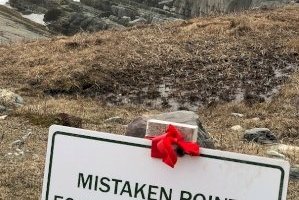
Joggins Fossil Cliffs is just a 2.5 hour drive from Halifax, Nova Scotia airport. The site is in a rural area located right on the Bay of Fundy. I was fortunate to visit on a beautiful day in May at low tide. As a result, I was able to walk below the cliffs to see how the extreme tides of the Bay of Fundy is eroding the cliffs and exposing fossils of trees and other plant life. The various coal seams and ridges of fossil remains along the beach also made the site visually interesting.
You'll need a car to visit this site as it is a couple of hours from - well - anywhere. Fortunately, the roads are great and there is no traffic. Once there, definitely make time to visit the Joggins Fossil Center - part museum/gift shop/visitor's center. Also, the 2 or 4 hour tours offered by the Fossil Center staff are excellent.
Keep reading 0 comments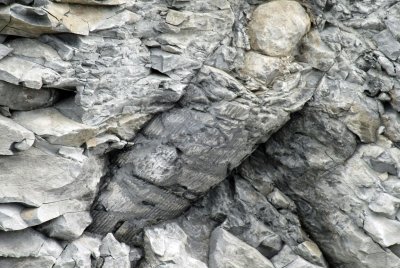
I think that I shall never see a fossil lovely as a tree... Although Joggins Fossil Cliffs does have some reptilian fossils, the vast majority of the fossils on display are of the arboreal variety. I visited Joggins on a cool September day in 2017 and joined a two hour tour on the beach below the cliffs. The tour guide very helpfully showed how the constant erosion of the cliffs was exposing fossilized tree trunks, and also displayed examples of fossils found exposed on the beach. A museum near the car park on the top of the cliffs provided an exhibit revealing what the prehistoric forests would have looked like for context. I enjoyed the tour, as well as the opportunity to wander around the beach afterwards and look for fossils. That said, I am not as much of a fan of fossil sites as I am of sites with natural beauty, so Joggins Fossil Cliffs resonated with me more for its scenic location along the Bay of Fundy. For those World Heritage Site travelers who love fossils, though, Joggins Fossil Cliffs is one of several Canadian sites that would be well worth a visit.
Logistics: Joggins Fossil Cliffs is in a remote location in western Nova Scotia, and requires private transportation for access.
Keep reading 0 comments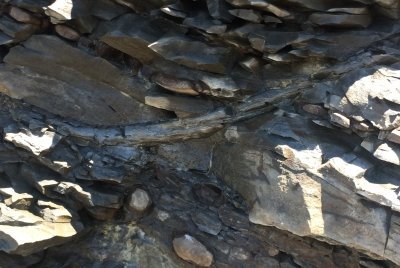
The cliffs are near the Nova Scotia border with New Brunswick.
Although we were told to book a day or two in advance to get the extensive tour, we were informed it was booked up when we followed that advice. However, when we arrived they allowed us to join the fully engaged two-hour tour. It was a very hot day, and we almost regretted having taken that extensive tour rather than the half hour option which would have been sufficient.
The guide was patient and spent most of the time answering questions about whether various rocks were fossils or just rocks It is definitely important to have a guide as many of the fossils, mostly of plants, are not easy to find on one’s own.
The seascape of the Bay of Fundy and its cliffs is attractive. Next time I would take the shorter tour because much of the time was taken up with questions from amateur geologists, including ourselves.
The Visitor’s Centre was pleasant, and we saw the oldest living fossil reptile called hylonomus lyelli. However, as this was our third fossil site of the trip, we were perhaps not as intrigued as for the first two. Also, fossilized plants and trees are not as interesting as the fish remains and primitive animal forms of Miguasha and Mistaken Point.
Visited 19JUL 2018
Keep reading 0 comments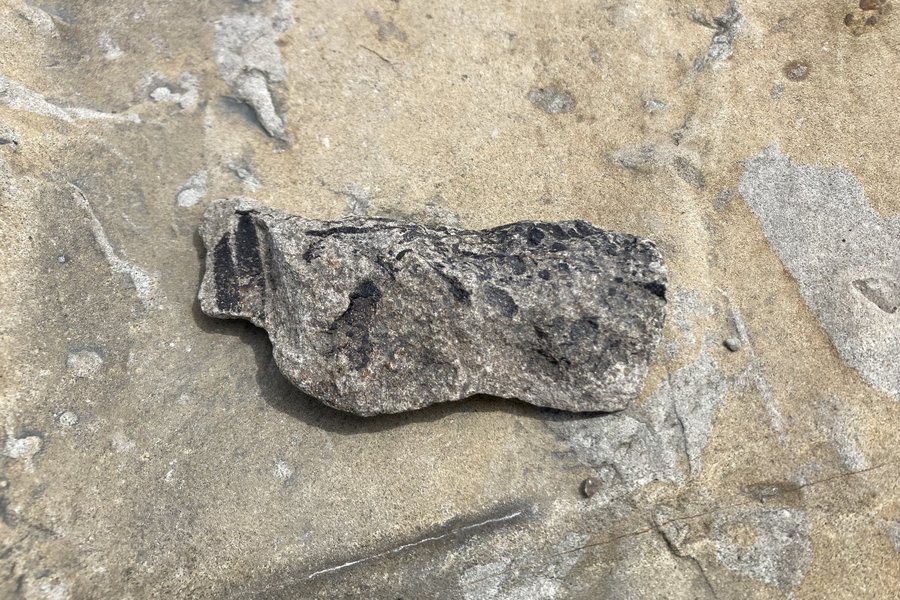
Joggins Cliffs are located in Northern Nova Scotia, near the border with New Brunswick. The billboards are clearly visible from both directions of the main Trans-Canadian road so it is easy to find the place even without GPS.
After my slight disappointment with Miguasha Park, I did not expect too much from another fossil site of Eastern Canada. But in fact, Joggins is much more interesting.
Unlike in Miguasha, the most interesting part of this site are cliffs and beach. Although it was extremely windy the day I visited Joggins (so windy that my 2-year-old son could not stand without keeping parent's hand on the beach), the visit was very interesting. You can do it on your own or with a guide and I recommend the second option, as it is easy to miss the most important parts of the cliffs. We started the tour from a place where there was a coal layer among other rocks. Then you move to remains of an ancient tree aged 300 million years! The most funny part is that you can touch it, take photos etc., so it is not comparable with any museum (by the way, the museum in Joggins is also interesting). The beach tour did not take long but was one of the most remarkable experiences during my 14-day trip to Canada.
Keep reading 0 comments
We visited the Joggins Fossil Cliffs in June 2010. We got there while the tide was still high, so we spent some time in the museum, had lunch, and were amazed how quickly the tide went out! Within an hour of our arrival we were able to go down the beach and explore. The cliffs are amazing--layer upon layer of rock and sediment deposited over millions of years. Fossils are easily found on the beach, and new material is brought in by the tide twice a day. Truly amazing.
Keep reading 0 comments
The fossil cliffs were really amazing, especially with the Bay of Fundy (known to have the highest tides in the world) right there beside them. We arrived there just in time for a tour with a docent, who took us to the beach during low tide. My daughter loved beachcombing for seaglass, which people are allowed to take. Fossils and rocks are prohibited for taking. Our docent was knowledgeable about the area and was available for people's questions, even after the tour. The centre is just as impressive, as it houses the fossil of the oldest reptile in the world. It also takes children into account and has a cave-like movie area in which one needs to crawl to enter. Stay in the centre for lunch, as the food is tasty and fairly priced. The souvenirs are also high quality. A couple of things to note: 1) the tour is a separate price from the entrance fee and 2) be aware of when high tide occurs, which will be posted in the centre. No tours on the beach will take place after high tide, much to the disappointment of some guests who arrived too late.
Keep reading 0 comments
The Joggins fossil cliffs are outstanding. Definitely worthy of recognition as a world heritage site. I have visited the site several times over the last 10 years, most recently in November of 2008. My son is doing a project for the National Heritage Fair and has chosen Joggins as his topic.
The staff at the fossil center (despite the center not being open) met with us and spent 2 hours answering my sons questions, taking us down to the cliffs on a very blowy and cold afternoon and generally being exceedingly kind and helpful.
The center is beautiful and the cliffs are highly interesting. I can't wait to visit on a warmer day in 2009.
Keep reading 0 comments
